Tucana constellation lies in the southern hemisphere. It represents the toucan, a bird found in tropical and sub-tropical regions.
The constellation was introduced by the Dutch astronomer Petrus Plancius from the observations of Dutch sailors Frederick de Houtman and Pieter Dirkszoon Keyser in the late 16th century. It was first depicted in a celestial atlas in 1603, in Johann Bayer’s Uranometria.
The constellation is home to the Tucana Dwarf galaxy, the Small Magellanic Cloud, the globular cluster 47 Tucanae, and several other notable deep sky objects.
Facts, location and map
Tucana is the 48th constellation in size, occupying an area of 295 square degrees. It lies in the first quadrant of the southern hemisphere (SQ1) and can be seen at latitudes between +25° and -90°. The neighboring constellations are Eridanus, Grus, Hydrus, Indus, Octans and Phoenix.
The constellation name Tucana is pronounced /tjuːˈkeɪnə/. In English, the constellation is known as the Toucan. The genitive form of Tucana, used in star names, is Tucanae (pronunciation: /tjuːˈkeɪniː/). The three-letter abbreviation, adopted by the International Astronomical Union (IAU) in 1922, is Tuc.
Tucana belongs to the Johann Bayer family of constellations, along with Apus, Chamaeleon, Dorado, Grus, Hydrus, Indus, Musca, Pavo, Phoenix and Volans.
Tucana contains three stars with known planets and no Messier objects. The brightest star in the constellation is Alpha Tucanae, with an apparent magnitude of 2.86. There are no meteor showers associated with the constellation.
Tucana contains three formally named stars. The star names approved by the International Astronomical Union (IAU) are Danfeng, Emiw, Lang-Exster, and Poerava.
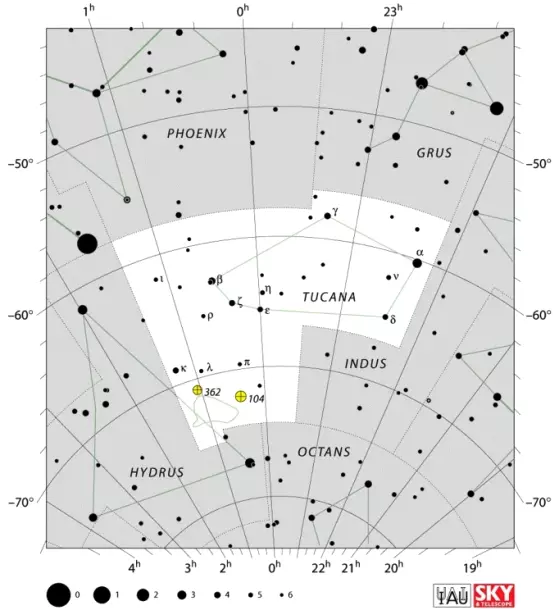
Tucana constellation map by IAU and Sky&Telescope magazine
Story
Tucana is not associated with any myths. The constellation’s name is Latin for “the toucan,” a South American bird with a huge bill. The Dutch astronomer and cartographer Petrus Plancius first depicted the constellation on a celestial globe in 1598 and gave it the name Tucana.
Johann Bayer kept the name in his atlas of 1603, but Frederick de Houtman called the constellation Den Indiaenschen Exster, op Indies Lang ghenaemt, meaning “the Indian magpie, named Lang in the Indies,” in his 1603 catalogue. Presumably, de Houtman was describing the hornbill, a different bird that is also native to the East Indies and Malaysia. In the end, the name Tucana won out.
Tucana stars
Lang-Exster – α Tucanae (Alpha Tucanae)
Alpha Tucanae is the brightest star in Tucana. It has an apparent magnitude of 2.86 and is approximately 184 light years distant from the Sun.
Alpha Tucanae is a spectroscopic binary system with an orbital period of 4197.7 days (11.5 years). The primary star is an orange giant of the spectral type K3 III. It has a mass 2.5 – 3 times that of the Sun and has expanded to a size of 37 solar radii as it evolved away from the main sequence. With an effective temperature of 4,300 K, it is 424 times more luminous than the Sun.
In 2024, the International Astronomical Union (IAU) formally approved the name Lang-Exster for Alpha Tucanae. Lang is a Malayan/Indonesian word for “hornbill” and exster is a Dutch word for “magpie.” Both terms were used when the constellation was created by Dutch explorers in the late 16th century.
γ Tucanae (Gamma Tucanae)
Gamma Tucanae is a yellow-white giant with the stellar classification of F1 III. It is the second brightest star in Tucana. It has an apparent magnitude of 3.99 and is 75.3 light years distant from the solar system. It is 1.55 times more massive than the Sun.
ζ Tucanae (Zeta Tucanae)
Zeta Tucanae is the third brightest star in the constellation. It is a yellow-white main sequence dwarf belonging to the spectral class F9.5V. It has an apparent magnitude of 4.23 and is 28.01 light years distant from Earth.
The star has 99 percent of the Sun’s mass, 108 percent of the solar radius, and is 1.26 times more luminous than the Sun. It emits excess infrared radiation, which indicates that it has a debris disk in its orbit. The star’s estimated age is about 3 billion years.
κ Tucanae (Kappa Tucanae)
Kappa Tucanae is a multiple star system in Tucana. It has a combined apparent magnitude of 4.25 and is 66.6 light years distant.
The Kappa Tucanae system is composed of two binary pairs separated by 5.3 minutes of arc. The primary component is a yellow-white subgiant star with the stellar classification of F6IV and a visual magnitude of 5.1. Its binary companion is located 5 arc seconds away and has an apparent magnitude of 7.3. The two stars have an orbital period of 1,222 years.
The other binary star in the system consists of a magnitude 7.8 and a magnitude 8.2 star separated by 1.12 arc seconds. The pair has an orbital period of 86.2 years.
β Tucanae (Beta Tucanae)
The Bayer designation Beta Tucanae refers to a group of six stars in Tucana that are loosely bound into a star system. The system is approximately 140 light years distant from the Sun. The brightest two components have visual magnitudes of 4.36 and 4.53. They are a blue-white dwarf and a white dwarf separated by 27 arc seconds. The brighter component has a magnitude 13.5 star for a companion, and the secondary component has a 6th magnitude companion. Both companions are white main sequence stars.
The system also contains a binary star separated from the two brightest components by 9 arc minutes. The binary system consists of two white main sequence dwarfs with apparent magnitudes of 5.8 and 6.0. The stars are separated by 0.1 arc seconds.
ε Tucanae (Epsilon Tucanae)
Epsilon Tucanae is a blue-white subgiant with the stellar classification of B9IV. It has a visual magnitude of 4.49 and is approximately 374 light years distant from the Sun.
δ Tucanae (Delta Tucanae)
Delta Tucanae is a binary system with an apparent magnitude of 4.51. It is about 267 light years distant from Earth.
The primary star is a blue-white dwarf belonging to the spectral class B9.5V. The companion is located 7 arc seconds away and has an apparent magnitude of 9.3.
ν Tucanae (Nu Tucanae)
Nu Tucanae is a red giant with the stellar classification M4III. It has a mean apparent magnitude of 4.91 and is approximately 273 light years distant from the Sun. It is an irregular variable star exhibiting variations in magnitude ranging from 4.75 to 4.93.
ι Tucanae (Iota Tucanae)
Iota Tucanae is a yellow giant belonging to the stellar class G5III. It is a semi-regular variable star and its brightness varies by 0.06 magnitudes. It has a visual magnitude of 5.36 and is approximately 279 light years distant from the solar system.
HD 219077
HD 219077 is a yellow main sequence dwarf with the stellar classification of G8V. It has an apparent magnitude of 6.12 and is 95.2 light years distant from Earth. The star has roughly the same mass as the Sun and 1.91 times the solar radius. It is 2.66 times more luminous than the Sun.
A planet was discovered orbiting the star in 2012. It has a mass at least 10.39 times that of Jupiter and orbits the star with a period of 5,501 days.
HD 4308
HD 4308 is another yellow dwarf with a confirmed planet. It has the stellar classification of G6V and an apparent magnitude of 6.54. The star is 71.9 light years distant from the Sun. It has 83 percent of the Sun’s mass and 92 percent of the solar radius.
The planet has a mass at least 0.0442 times that of Jupiter and it completes an orbit around the star every 15.56 days.
HD 221287
HD 221287 is a yellow-white dwarf with the stellar classification of F7V. It has a visual magnitude of 7.82 and is 172.5 light years distant from the solar system.
A planet with a minimum mass of 3.12 times that of Jupiter was discovered orbiting the star in March 2007. It completes an orbit every 456.1 days.
HD 215497
HD 215497 is an orange dwarf star belonging to the spectral class K3V. It has an apparent magnitude of 8.96 and is approximately 142 light years distant from Earth. The star has 87.2 percent of the Sun’s mass, about the same radius, and only 39 percent of the Sun’s luminosity.
Two planets, both less massive than Jupiter, were discovered orbiting the star in 2009. The inner planet has a mass at least 6.6 times that of the Earth and orbits the star every 3.93404 days. The outer planet has at least 0.33 times the mass of Jupiter, which makes it roughly the same size as Saturn, and an orbital period of 567.94 days.
HD 5980
HD 5980 is a star located in the open cluster NGC 346 and the brightest object in the Small Magellanic Cloud. It is in fact one of the most luminous stars known. It has an apparent magnitude of 11.31 and a combined absolute magnitude of -7.3. The star is approximately 200,000 light years distant from the solar system.
HD 5980 consists of three components and all three are among the luminous stars known. The primary component in the system is a Wolf-Rayet star that has produced a luminous blue variable eruption. Wolf-Rayet stars are evolved, exceptionally hot, highly luminous and very massive stars that are rapidly losing mass as a result of a strong stellar wind. The secondary component is also a Wolf-Rayet star and forms an eclipsing spectroscopic binary with the primary star. The stars have an orbital period of 19 days. The third component in the system is a blue, class O supergiant which may not be physically associated with the other two stars and may itself be a close binary.
The Wolf-Rayet stars have masses 58-79 times (component A) and 51-67 times (component B) solar. The primary star is 2 million times more luminous than the Sun, as is the blue supergiant, while the secondary component has 2.5 million solar luminosities.
Deep sky objects in Tucana
Tucana Dwarf
The Tucana Dwarf is a dwarf spheroidal galaxy with an apparent magnitude of 15.7. It is approximately 3.2 million light years distant from Earth. The galaxy was discovered by R. J. Lavery in 1990.
The Tucana Dwarf contains only very old stars and has no galactic neighbours. Unlike other isolated dwarf galaxies, it is not experiencing any star forming activity.
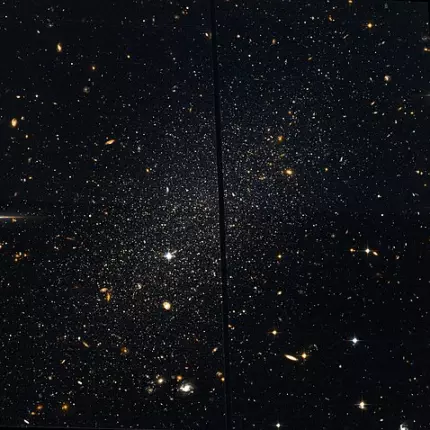
Tucana Dwarf, image: NASA (the Hubble Space Telescope)
Small Magellanic Cloud
The Small Magellanic Cloud is a dwarf galaxy usually classified either as a dwarf irregular galaxy or a Magellanic type dwarf spiral galaxy. It is a companion galaxy to the Milky Way and a member of the Local Group of galaxies. It has an apparent magnitude of 2.7 and is approximately 197,000 light years distant from the solar system. The galaxy is one of the most distant deep sky objects that can be seen without binoculars.
The Small Magellanic Cloud contains several hundred million stars. It has a central bar structure. It is possible that it used to be a barred spiral galaxy once, but its structure was interrupted by interactions with the Milky Way.
SMC can only be seen from the southern hemisphere and lower northern latitudes. It appears as a patch of light spanning about 3 degrees.
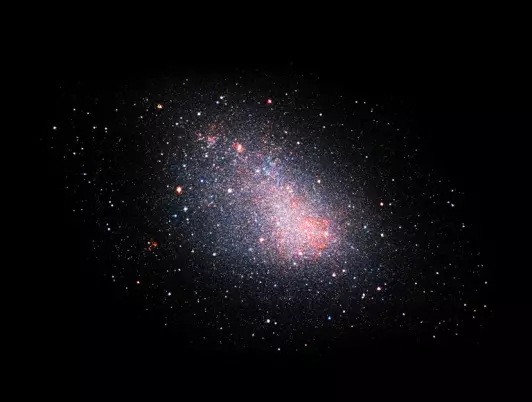
Small Magellanic Cloud, image: Pablo Carlos Budassi (CC BY-SA 4.0)
The galaxy forms a pair with the Large Magellanic Cloud, located about 20 degrees to the east, in the constellations Dorado and Mensa. The two galaxies are connected by a bridge of gas and believed to be tidally interacting. The bridge is a site of intense star formation. There is evidence that suggests that the two galaxies have been gravitationally bound for a long time.
NGC 346
NGC 346 is an open star cluster associated with a nebula in the Small Magellanic Cloud. The cluster contains the luminous star HD 5980.
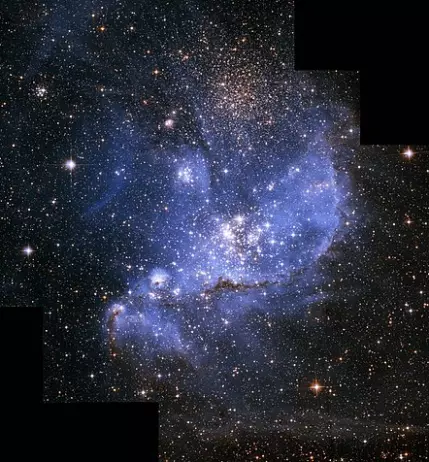
NGC 346 in the Small Magellanic Cloud – Hubble astronomers have uncovered, for the first time, a population of infant stars in the Milky Way satellite galaxy, the Small Magellanic Cloud (SMC, visible to the unaided eye in the southern constellation Tucana), located 210,000 light-years away. Hubble’s exquisite sharpness plucked out an underlying population of infant stars embedded in the nebula NGC 346 that are still forming from gravitationally collapsing gas clouds. They have not yet ignited their hydrogen fuel to sustain nuclear fusion. The smallest of these infant stars is only half the mass of our Sun. Although star birth is common within the disk of our galaxy, this smaller companion galaxy is more primeval in that it lacks a large percentage of the heavier elements that are forged in successive generations of stars through nuclear fusion. Fragmentary galaxies like the SMC are considered primitive building blocks of larger galaxies. Most of these types of galaxies existed far away, when the universe was much younger. The SMC offers a unique nearby laboratory for understanding how stars arose in the early universe. Nestled among other starburst regions with the small galaxy, the nebula NGC 346 alone contains more than 2,500 infant stars. The Hubble images, taken with the Advanced Camera for Surveys, identify three stellar populations in the SMC and in the region of the NGC 346 nebula — a total of 70,000 stars. The oldest population is 4.5 billion years, roughly the age of our Sun. The younger population arose only 5 million years ago (about the time Earth’s first hominids began to walk on two feet). Lower-mass stars take longer to ignite and become full-fledged stars, so the protostellar population is 5 million years old. Curiously, the infant stars are strung along two intersecting lanes in the nebula, resembling a “T” pattern in the Hubble plot. Image: NASA
NGC 104 – 47 Tucanae
NGC 104 is a globular cluster in Tucana. It has an apparent magnitude of 4.91 and is approximately 16,700 light years distant from Earth. The cluster is about 120 light years across, has a very bright and dense core, and can be seen without binoculars. It is the second brightest globular cluster in the night sky, after Omega Centauri in Centaurus constellation.
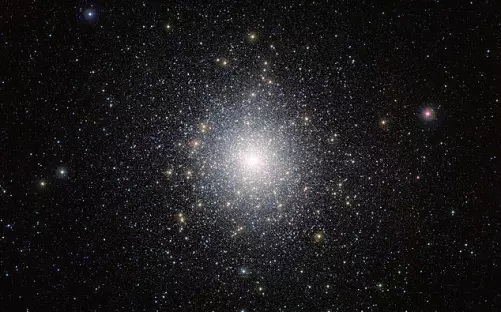
This bright cluster of stars is 47 Tucanae (NGC 104), shown here in an image taken by ESO’s VISTA (Visible and Infrared Survey Telescope for Astronomy) from the Paranal Observatory in Chile. This cluster is located around 15 000 light-years away from us and contains millions of stars, some of which are unusual and exotic. This image was taken as part of the VISTA Magellanic Cloud survey, a project that is scanning the region of the Magellanic Clouds, two small galaxies that are very close to our Milky Way. Image: ESO/M.-R. Cioni/VISTA Magellanic Cloud survey
NGC 104 was discovered by the French astronomer Nicolas Louis de Lacaille in 1751 while he was mapping the southern skies in South Africa.
The cluster contains millions of stars and is one of the most massive globular clusters known in the Milky Way.
NGC 406
NGC 406 is a spiral galaxy in Tucana constellation. It is approximately 60,000 light years across and about 65 million light years distant from Earth. It resembles the more famous Whirlpool Galaxy in Canes Venatici constellation.
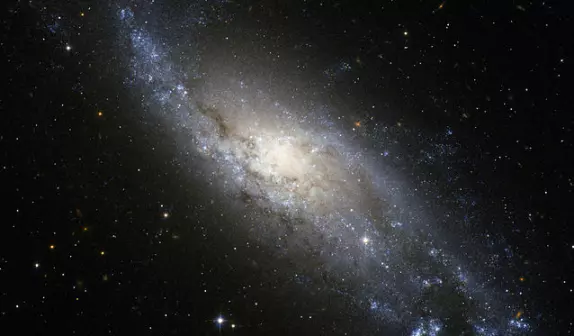
The beautiful spiral galaxy NGC 406 was discovered in 1834 by John Herschel. Located about 65 million light-years away, in the southern constellation of Tucana, NGC 406 is about 60 000 light-years across, roughly half the diameter of our galaxy, the Milky Way. It is a spiral galaxy quite similar to the well-known Whirlpool galaxy (Messier 51). In a moderate-sized amateur telescope NGC 406 would appear as a faint hazy blob, like thousands of others across the sky, and none of the spectacular fine detail in the Hubble picture could be made out. In this image the galaxy exhibits spiral arms that are mainly populated by young, massive, bluish stars and crossed by dark dust lanes. As is typically observed in this kind of spiral galaxy, the yellowish central bulge, dominated by an older stellar population, is less prominent and almost totally embedded in the disk structure. The deep image also shows a significant number of more distant galaxies in the background. Some of them are visible as reddish fuzzy spots through the bluish spiral arms of the foreground galaxy. Image: ESA, Hubble, NASA
NGC 362
NGC 362 is a globular cluster. It has an apparent magnitude of 6.4 and is approximately 27,700 light years distant from Earth.
The cluster was discovered by the Scottish astronomer James Dunlop on August 1, 1826. It is quite bright and can be seen in a small telescope.
NGC 248
NGC 248 is an emission nebula in Tucana. It was discovered by the English astronomer John Herschel in on April 11, 1834.
NGC 265
NGC 265 is an open cluster located in the Small Magellanic Cloud. It is approximately 200,000 light years distant from the solar system. The cluster is about 32 light years in radius.
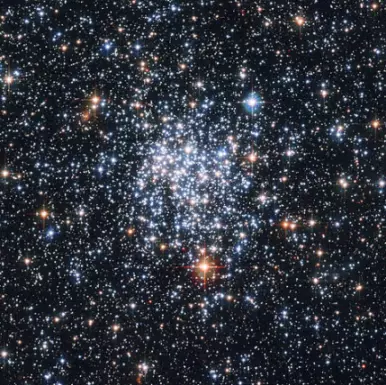
NGC 265, image: ESA, NASA, E. Olszewski (University of Arizona)
NGC 290
NGC 290 is another open cluster in the Small Magellanic Cloud. It is 65 light years across.